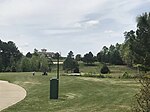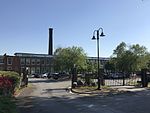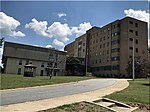Dr. Elmo N. Lawrence House
Houses completed in 1922Houses in Wake County, North CarolinaHouses on the National Register of Historic Places in North CarolinaNational Register of Historic Places in Wake County, North CarolinaWake County, North Carolina Registered Historic Place stubs
Dr. Elmo N. Lawrence House is a historic home located near Raleigh, Wake County, North Carolina. It was built about 1922, and is a 1+1⁄2-story, five-bay, Bungalow / American Craftsman-style dwelling built of concrete block and coated in cement stucco. It has a side-gable roof with shed dormers. Also on the property is a contributing garage.It was listed on the National Register of Historic Places in 2005.
Excerpt from the Wikipedia article Dr. Elmo N. Lawrence House (License: CC BY-SA 3.0, Authors).Dr. Elmo N. Lawrence House
Lawrence Drive, Raleigh
Geographical coordinates (GPS) Address Nearby Places Show on map
Geographical coordinates (GPS)
| Latitude | Longitude |
|---|---|
| N 35.7525 ° | E -78.668055555556 ° |
Address
Lawrence Drive 2000
27603 Raleigh
North Carolina, United States
Open on Google Maps








